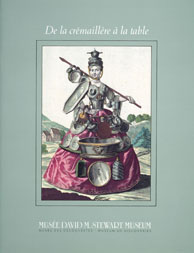Common menu bar links
Institutional links
ARCHIVED - Bon appétit!
A Celebration of Canadian Cookbooks
Archived Content
This archived Web page remains online for reference, research or recordkeeping purposes. This page will not be altered or updated. Web pages that are archived on the Internet are not subject to the Government of Canada Web Standards. As per the Communications Policy of the Government of Canada, you can request alternate formats of this page on the Contact Us page.
History of Canadian Cookbooks
Revolutions In The Kitchen

De la crémaillère à la table : ustensiles de cuisine et d’âtre, trois siècles d’artisanat. [Compiled] by Catherine Arminjon. Montréal: David M. Stewart Museum, 1986
It is difficult for us to grasp just how labour intensive preparing food was in the primitive kitchens of Canada's early settlers. Cooks throughout most of the 18th and 19th centuries had to do everything by hand. Trees had to be cut down, firewood cut and split and then carried to the kitchen wood box. Fireplaces, and later wood stoves, required constant attention. Refrigeration was provided by cool running springs or a cold box buried in the ground. Bread was made at home. Butter was churned by hand. Food was either eaten fresh or dried: commercial canned goods and home-canning methods were not yet available.
Cooking information and techniques were passed down from one generation to the next by word of mouth. They were based on general rules and rough measurements (e.g., a sufficient quantity, a teaspoon of this, a teacup or a handful of that). "Cooks who didn't rely on buzzers, timers, thermometers and burners had, and have, a sensory relationship to their cooking and baking that others lack. Farm women who tended fowl were not flummoxed by 'butter the size of a duck egg'." (Fiona Lucas, "Fiona's Musings." The Culinary Historians of Ontario. No. 29 (Summer 2001), p. 4.
In the second half of the 19th century, baking powder, compressed yeast, powdered gelatin and glass preserving-jars came into use. By the end of the century, the first canned goods had arrived on the shelves. In the 20th century, technological innovations would transform the Canadian kitchen.

